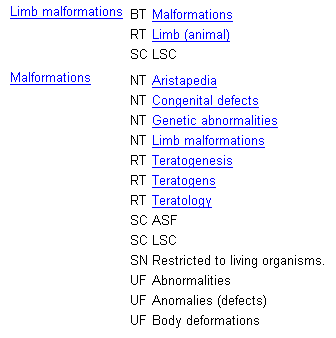Understanding Thesaurus Results

Sample record from Biocomplexity Thesaurus
Let's look at an actual entry in the Biocomplexity Thesaurus.
A search on the term "malformations" yields several relationships, seen in the image at right.
Our search term "malformations" produced partial or full matches for two entry terms in the thesaurus: "limb malformations" and "malformations." The hyperlinked terms indented beneath each entry term are facets of that entry term, concepts related hierarchically or associatively to the entry term.
- BT stands for "broader term"
- RT stands for "related term"
- NT stands for "narrower term"
- UF stands for "use for"
- SC stands for "subject category"
- SN stands for "scope note"
BT and NT are hierarchical relationships. They demonstrate large concepts or classes (broad terms) and member or subordinate classes (narrower terms).
RT is an associative relationship; two concepts may be related, or overlap, but one concept does not encompass the other.
UF (and its inverse, USE) are equivalence relationships; they indicate that two concepts are equivalent, or equal, but indicate which term is the preferred term (USE), and which term(s) are not preferred (UF).
Let's look at our first entry term result, "limb malformations."
- "Limb malformations" are skeletal malformations; the broader concept that would encompass all types would be simply "malformations" (BT=malformations). Click on the hyperlinked "malformations" to view other facets of the term.
- Many other concepts are associated with limbs. Our entry term "limb malformation" touches on the the idea of a limb that has not formed normally; however, there are also types of limbs, synonyms for the term "limb", and other related concepts (RT=limb (animal)). click on the hyperlinked "limb (animal)" to view related concepts.
- SC=LSC tells us that the terms relationships were determined from the CSA Life Sciences (LSC) Thesaurus.
Next, we'll look at results for our second entry term, "malformations":
- Four "narrower terms" exist within the Biocomplexity Thesaurus for our entry term, including "limb malformation" from our previous example. Narrower terms should be selected when the intended concept is more specific than the entry term. For example, "aristapedia," one of the NTs listed in this example, is a mutation in insects that results in malformed antennae. Malformed antennae are but one member of the more general class of malformations; therefore, "aristapedia" is a narrower concept or class of the larger concept "malformations." One would thus use the term "aristapedia" only when speaking specifically of a malformed antenna and not, say, a malformed hind-limb.
- a scope note (SN) is also indicated for this entry term. Scope notes may demonstrate a particular restriction on meaning, or may provide guidance as to when a term should or should not be used. In the case of our example, "restricted to living organisms" indicates that the term malformation should not be used to characterize non-living anomalies, such as a geologic formation or a man-made structure.
- Several non-preferred terms (UF) are indicated for our entry term. If a user were to have looked up "abnormalities," s/he would be instructed to "USE malformations." Malformations is the preferred term, and users should not use the synonyms "abnormalities," "Anomalies (defects)," or "body deformations" when indexing, classifying, or describing a concept or resource.
